
- Home
- Memories
- Scrapbook ▽
- Topics ▽
- People ▽
- Events
- Photos
- Site Map
- Timeline
Page updated 16th April 2012
Return to Industrial Exeter
Although never on the same scale as the potteries in Stoke-on-Trent, the production of pottery in Devon has been quite extensive, especially during the late 19th and 20th centuries, as tourism provided a ready market for souvenirs and art pottery. Production was especially centred on Torbay and Bovey Tracey as one of the main raw materials, white ball clay was readily available from the Bovey beds. Thus, a small, but skilled group of potters developed, producing hand thrown, slip decorated pots for the tourist market.
In 1891, one such potter, Kingsteignton born, 36 year old William Hart, who had worked at the Aller Vale pottery at Newton Abbot was taken on as a potter and manager of the Messrs Cole and Trelease's Exeter Art Pottery situated at 7 Exe Street, just close to the junction with Bonhay Road. Nothing is known about Cole, but it is known that John Trelease was a draper in the High Street.
The pottery announced the opening of a new showroom at 1, Luxury Lane, off the Bonhay Road in March 1891. The advert gave an indication of their output at this time "designs in Rhodian (after the 17th century), Bartbotine (Bas Relief), the new Primrose Ware on a bright red ground, Renaissance (a pretty design with coloured grounds), Maltese, &c." Their wares were influenced by Greek classical and European design. They also offered clay and pottery supplies along with space in their kiln to local amateurs. One local stockist of their finished ware was Messrs. H B Jeboult and Son, glass dealers, of 198 High Street. A small add in April was placed for a 'strong boy' to apply to the Devon Art Pottery, Bonhay Road.
By 1892, John Trelease was listed as the manager at the Exeter Art Pottery, 7 Exe Street. William Hart lived at 9 Dinham Road in 1891, with his wife Susan, and three sons and three daughters. By 1892 he had moved to 8, West View Terrace, just off Exe Street, very close to the pottery.
The pottery supplied two examples of their work to the Bishop of Exeter, Henry Bickersteth who sent them a letter of thanks. It was addressed to Hart and Bulley:
"My
Dear Sirs,
I beg to thank
you sincerely for the two beautiful specimens of the Exeter Art Pottery
which you have been kind enough to send me. The vases will greatly
adorn my dining-room, and I hope that this new artistic industry will
take deep root here, and will employ many cultured designers and
skilled workmen in our city.
Yours
faithfully,
E. H. Exon."
Industry and art were encouraged at this time, and the pottery had a visit from Sir Stafford Northcote in July 1891, as part of his support for local industries. Six months later they produced for Messrs. T R Purnell and Sons, the coal merchants, a limited edition, artistic "Geological bottle" with their trademark word Sunshine on the body of the pot. They were offered at a nominal price, a nice example of a Victorian promotional gift.
In 1893, Hart was joined by Bovey Tracey born and trained, 31 year old Alfred Moist who had been working in Gloucester as a potter, in 1891, and then at the Bovey Tracey Pottery. Moist lived with his wife Emma, and two daughters and one son, at 10, Albion Terrace, St Thomas. It is probable that Moist did most of the throwing and Hart the decoration. They used local brown clays, from the clay beds at Monks Road, that were the main source for the Exeter Brick and Tile Company's Rougemont Works. The clay is fairly distinctive, having a finished red rather than brown colour, it is course with black and white specks. The decorative white slip was from Bovey Tracey. The ornamental vases were stamped on the base 'MADE AT THE EXETER ART POTTERY' circling the Exeter castle of three towers from the city coat of arms.
In February 1894, John Trelease left Exeter, and John Boundy, a tanning and hide merchant became the new owner. He fronted the Exeter Art Pottery's stand at the 1894 Devon County Show. A short feature appeared in the Flying Post.
".... The Exeter Pottery Works are in a flourishing condition, and that since the change of proprietorship a great improvement has been made in the ware. .... In the course of a very appreciative article on the ware in Le Follet (a fashion magazine published in English and French between 1846 and 1900) it is remarked:- Novelties in decoration are always welcome, doubly so when attractions of form and colour are added to their originality, for these artistic qualities last after the "novelty" has long departed. The new "Exeter Art Pottery" possess all these attractions, and added to them the very important one of its being entirely of English production. Therefore the smallest article purchased is a direct benefit to English workers, and an encouragement of English art."
The carpet beating business of C Webber moved into the old Art Pottery Works on 25th June 1896, after a fire at its previous premises in Bonhay Road.
The Exeter Art Pottery had closed, and William Hart and Alfred Moist formed a new partnership, purchased a field and a cob barn at Haven Road, and set up their own pottery to produce what would be known as Devon Art Pottery. Alfred's brother, Joseph, who had been working at Burslem, in the heart of the Stoke pottery, joined the new concern in 1897. They still used the Monks Road clay which was transported by horse and cart from the brick works. The company also extracted clay and sand from a site in Tan Lane. This site was eventually occupied in 1939 by Garton and King when they moved their foundry from Waterbeer Street. Henry Holladay who planned the move wrote "The Tan Lane site had been a pit, first where sand/clay was extracted for a small pottery which used to be in the sheds between the meter works (Willeys) and the railway. The pit was later filled with the rejects from the pottery."
By the turn of the century business was flourishing and the partners had built drying sheds, a warehouse and a decorating shop in their field, and also replaced the box kiln with a larger down draught kiln in 1902. A box kiln is basically a cube of fire bricks, with a fire beneath which feeds the hot gasses through the interior and out through an opening at the rear. The larger brick built down draught kiln is also rectangular in shape, with a domed roof. The hot gases from the fire are directed up the side walls into the domed roof and then forced down through the wares sitting on the kiln shelves, to exit through a channel in the floor and up the chimney.
Worth and Co., of Cathedral Yard advertised themselves as the sole agency for Exeter Art Pottery, indicating that the tourist trade was an important market. In 1905, Princess Frederica visited Worths' Gallery, located in Mol's Coffee House – she then went on to visit the Exeter Art Pottery.
Charles Collard, worked for them briefly in 1891; although there is no definitive proof, it is probable that he returned to the pottery in 1902 from the Aller Vale Pottery and brought with him his decorative skills. During this time, the quality of manufacture and design of the output of the pottery was particularly fine, partly attributable to Collard. He was not altogether happy at Hart and Moist, preferring a more purist 'art pottery' emphasis on production, and he left after a year for the Longpark Pottery at Torquay. Collard eventually started his own pottery in Poole before establishing a reputation running the Honiton Pottery from 1918.
The Western Times reported the funeral of Alfred Moist, at the age of 48, on Saturday 6th August, 1910 at the St Thomas Cemetery. His coffin was carried by eight employees of the firm. Alfred Moist's brother continued with the firm and in October 1913 was selected for the Liberal candidate for Cowick Ward at the Exeter Municiple Elections.
William Hart continued through the First War producing pottery from the works, although some of the male workers would have been called up. In April 1917, the Military appealed against a decision to call up W J Penticost, a mould maker and handler for the firm. The Chairman remarked "What happens when your moulder gets measles?" Mr Moist replied that "He has never had them." The Military lost the appeal as the Chairman remarked "Keep your export trade up, please." One who had worked for the Devon Art Pottery, and did serve, was Petty Officer Frank, R Goss RN, of Summerland Street. In January 1919, he was awarded the vellum of the Royal Humane Society for a rescue undertaken at great personal danger, in Gibraltar.
Devon Art Pottery pieces were mostly wheel thrown, although slip casting was employed. The technique involves a mould made out of plaster-of-paris into which is poured, and then emptied, liquid clay, leaving a layer of clay lining the mould, forming a hollow vessel after the two or more sections of the mould are released.
Up until 1920 the base of the pots were impressed H M Exeter, or sometimes a circular Royal Devon Art Potteries England was applied from a rubber stamp.
The pottery trained up local girls to decorate the pots, which were similar in style to those of Aller Vale, where William Hart had previously worked. The pottery was never very large in comparison with those in Torquay and Bovey and the workforce was never greater than about ten.
After the pot was thrown it was allowed to become leather hard before it was, dipped in or, painted with a liquid clay, often in a contrasting colour to that of the base. Scraffito designs are scraped and scratched through to allow the body colour to show through. Sometimes the slip is painted on or dribbled to give a design. Some pieces, had overglaze colours painted on and many plates, pin holders, ashtrays and decorative jugs were produced for the growing number of tourists visiting the coastal resorts by train. Popular designs included flowers, especially the daisy pattern, while a cockeral, along with a motto was also produced in significant numbers.
After William Hart retired, in 1920, the pottery started turning out cheaper, seaside souvenirs, often with mottoes. Such phrases as:
'Never a woman yet good or ill, But always did get her own free will.'
And 'Make the best of a bad bargain' alongside a stylised crowing cockerel.
Devonshire dialect was often added such as 'If you can't be aisy be aisy as you can'.
The business foundered during the downturn after the 1929 stock market crash, and on the 30th December 1932 they filed for bankruptcy. An advert was placed in the Exeter and Plymouth Gazette in May 1933 for a sale at the Bude Hotel for a "Valuable FACTORY SITE and BUILDINGS extending to nearly ONE ACRE, in TAN LANE, Haven Banks, and recently in the occupation of the Devon Art Pottery." That was the end of pottery production in Exeter.
Other potteries in Devon survived until the 1970s, but most have closed. The Cardew Pottery at Bovey Tracey still produces decorative teapots and caters for the many visitors to the area. Specimens of Royal Devon Art Pottery come up on Ebay from time to time and are well sought after, without being too expensive.
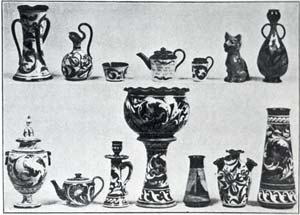 A Hart and Moist advert placed in the January 1904 Pottery Gazette, showing a range of output. Click to enlarge.
A Hart and Moist advert placed in the January 1904 Pottery Gazette, showing a range of output. Click to enlarge.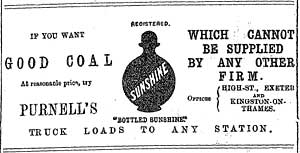 The coal-merchant,
Purnell's advert showing the bottle logo that the Exeter Art Pottery
turned into a promotional gift.
The coal-merchant,
Purnell's advert showing the bottle logo that the Exeter Art Pottery
turned into a promotional gift.
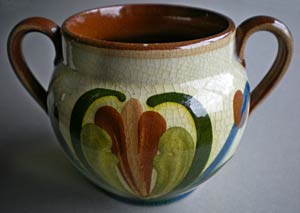 A Hart and Moist pot, probably
from after the First World War.
A Hart and Moist pot, probably
from after the First World War.
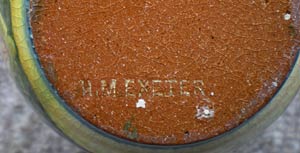 The Hart and Moist stamp on the
base. The mark under the R, is one of three, was made by the points of
the support in the kiln, to prevent the glaze fusing to the shelf.
The Hart and Moist stamp on the
base. The mark under the R, is one of three, was made by the points of
the support in the kiln, to prevent the glaze fusing to the shelf.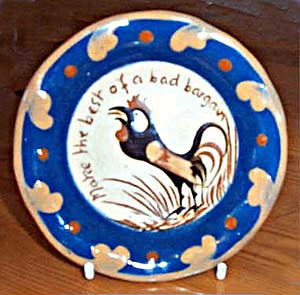 A typical Hart and Moist plate.
Courtesy of Carol Gilbert.
A typical Hart and Moist plate.
Courtesy of Carol Gilbert.
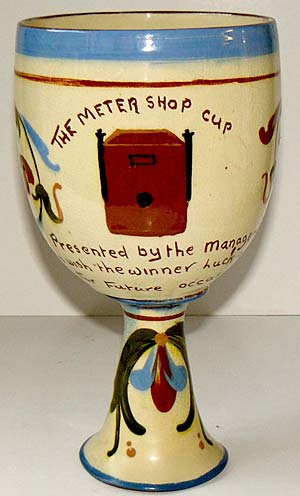 ‘The Meter Shop Cup Presented by the
Management who wish the winner luck and energy for future occasions’
- A Hart and Moist cup made for Willeys Foundry. Photo Andy Violet.
‘The Meter Shop Cup Presented by the
Management who wish the winner luck and energy for future occasions’
- A Hart and Moist cup made for Willeys Foundry. Photo Andy Violet.
│ Top of Page │